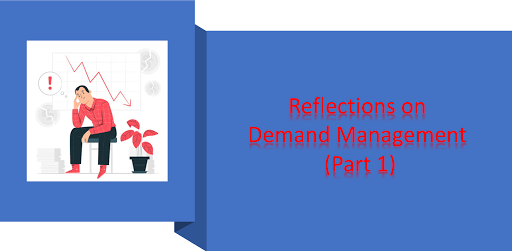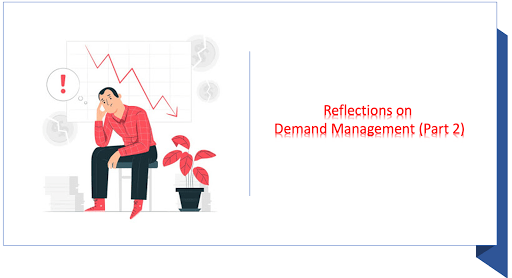Reflections on demand management (Part 1)

Sunday.
Today my day started by recapitulating and sharing a book: “Factfulness: Ten reasons why we are wrong about the world. And why things are better than you think. ” Anna Rosling Rönnlund, Hans Rosling and Ola Rosling book
It said something like this: ” Knowledge based on data should be a maxim for all aspects of your life. In any problematic situation where decision-making is required, data is essential.
This awareness involves, in principle, an attitude of humility at every crossroads, by virtue of the certainty that no one can know all the data related to a situation. For this reason, it is always possible to recognize ignorance and wait until you have more data to express an opinion. Like children, adults must continually foster their curiosity to gradually increase their understanding of things. “
The book and the previous idea serve us all.
They will read demand management topics, the importance of knowing what place we occupy in the service process, the importance of technological resources, and some questions about automation.
Below, I’m going to write something that may be helpful to those just starting out or curious about the complexity of serving customers whether it’s in the Contact center, in stores, or anywhere there are lines / queues.
The challenge is to understand demand so that we can later adjust capacity and provide the best possible service (in terms of speed and consistency). For this, we need information and business vision.
Today more than ever, we are in a crisis and everything is changing, we are accelerating processes.
Quarantine and what is already our “new reality” means that all the data we have are under discussion, from those related to forecasts (because nobody knows how this will continue), through to operational data (because the new reality of the telecommuting changed / created several indicators) … and generates even more data … is it enough with what we were measuring?
This personal and global situation caused me many questions , and incidentally, I wanted to write it to share.
Disclaimer: I work in demand management, workforce, and customer service, know that everything I will write is not in absolute quality, it is a reflection. Welcome the opinions and comments.
Where we are?
To analyze the information we have, it is important to know where we are, what role we play in the customer service process, because that will surely limit our access and the scope of the analysis.
- · We are a company that has its own contact / stores?
- · We are a customer service provider?
- · We are a service channel within a multinational? One of how many?
- · Are we an area within the care process?
- · We are the last part of a chain of processes where the client is served?
- · Does the care go one way or does it go back and forth between areas?
Business vision, thinking from the customer’s eyes, is not always possible for everyone, simply because they do not have enough information to put together that map.
Do we see the entire customer journey?
IT areas
If we are a “normal” company, the world of connectivity and in general the IVRs, all telephony and sometimes even reports, will be in government and control of IT areas. This is very positive, because they are the specialists with the training and the ability to make things work.
The only detail is that their data, their information is usually not available, and Operations (responsible for channels, or customer service) do not know or measure, nor are they used to seeing. The information is not always expressed in business terms. It also happens, they participate in the implementation of the technology, but not in the development of the business below.
There are many problems that originate in connectivity and its correct dimensioning, also in people who do “tricks” and modify the information we receive.
Examples:
Inbound: We set up an operation of 50 advisers, but due to quarantine, we grew to triple that number. The initial infrastructure is not enough no matter how much we have people, we do not have channels. How does the client feel it? It calls and makes it busy. Faced with such a critical situation for the customer experience, how does the operation find out? You do not know, those calls do not exist if they do not enter the flow, are not recorded, do not record customer information or reason for calling. Only a report of channels can see that they are saturated, and that they need to be expanded.
One outbound: We set up an outgoing call operation with a dialer. We started with 15 people and quickly grew to 50 people given the good initial results. To our surprise, the base sweep advance, which was initially very good, did not grow at the same speed as the operation. The occupation of the agents fell noticeably and the account was no longer profitable. If, you guessed it, there were not enough channels for the necessary calls of an operation that grew, simply people did not have calls because the limit was set by the available channels to dial.
One of stores: We have a ticket system in the store that measures demand. The venue cannot exceed 100 people. We also have a hostess, who depending on how she sees the entrance of clients, generates tickets and delivers them. Sometimes it spawns a lot together to have on hand to avoid long lines. There may be some left over and at the end of the day he throws them away, some clients can also go through the box without a ticket, things like that happen daily. These are the data we use to forecast our demand, those of the ticket machine, when the only person who knows the demand in detail is the hostess.
This seems like something out of a movie, it happens with many implementations: the initial resource planning changes over time, and the installed capacities do not adjust, generating a drop in performance, low occupancy, loss of profitability, etc.
The size of the “pipe” will be our maximum limit. We must never forget that the capacity of the channels, of the connectivity, of the centrals, is ahead of all the operational numbers that we see.
This information should not be used exclusively by IT areas, much less at times when demand fluctuates and can easily exceed installed capacity. Having telework consultants, connectivity is the first thing to measure, to ensure that we do not have missed calls due to the new topology.
At the same time, people modify what is designed, generating deviations in the process.
We have to know and ensure that what is written on paper, is what happens in reality, the experience that the client lives.
It is important then to have availability of the information of the calls, in the whole process of attention.
We should monitor or at least have alerts of:
- · Link saturation
- · Channel saturation
- · Packet loss
- · Dropped calls without registration
- · Customer complaints about not being able to communicate
Artificial Intelligence (?) And Self-management
It is time to automate.
The digital transformation has advanced in these months, which was expected to advance in years.
Technology allows us to develop self-management solutions, which once implemented should provide consistent responses, with a low failure rate and 100% availability, at low cost.
There are several features and, in general, a good implementation can achieve it. There are many examples of bots and self-management systems, and they are part of our daily reality.
This “contained” demand must be monitored not only with service indicators, but also with experience indicators to ensure that they do not fail and that they add value.
Some questions to ask the team to implement:
- What happens if it fails? How does the demand impact?
- What detours will I get when it doesn’t work? Does it fail often?
- What happens if you give incorrect information? What will happen to our client, follow or hang / cut? Does the client perceive it as silence, incorrect information?
- It applies to stores, if we put some self-management totems, what happens if it is unplugged, who updates the content it provides?
Client: I want to speak to a person, thanks
BOT: Thanks to you for communicating, come back soon.
Being today a very important percentage of the total number of services in the different channels, the self-management and bot’s metrics should be known to everyone.
When was the last time your robot failed? How many customers went through there?
This is where my Sunday came to.
These are some lines with the idea of pushing us to review things that we did not see before.
A new reality requires asking different questions, expanding our vision and adapting.
Do I have all the information necessary to make decisions, just as Mr. Rosling’s book said?
Mmm I declare myself ignorant of some.
I’ll keep asking
Gabriel
Gabriel Pizarro Garcia









Responses